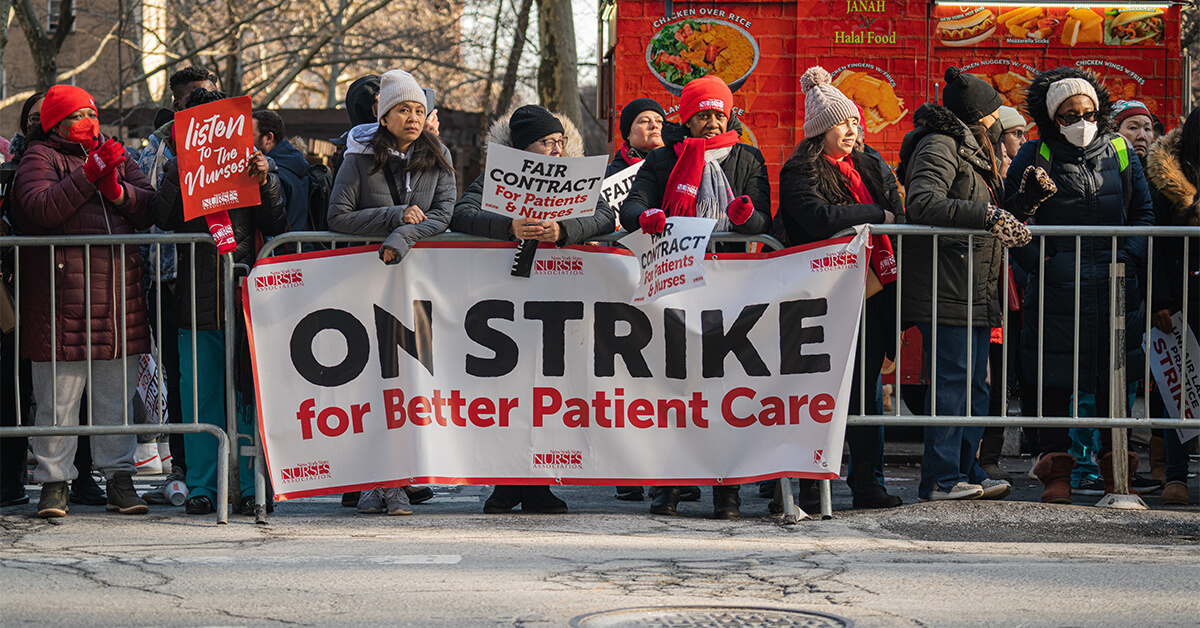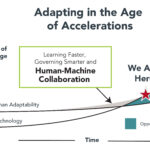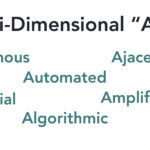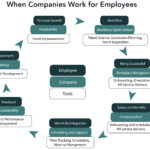February 16, 2023

The Way Healthcare’s Working Isn’t Working (Part 2): Changing Mechanics
Note: This is Part 2 in a series about system dynamics in healthcare, exploring how healthcare organizations can change their mechanics along with their mindsets to serve their employees, patients and communities with greater effectiveness, compassion and sustainability. Read Part 1 here.
On January 9, 2023, over 7,000 nurses walked off the job at Mount Sinai Hospital and Montefiore Medical Center in New York City after four months of failed negotiations between the hospitals and their union, the New York State Nurses Association (NYSNA). Although higher pay was among their demands, the nurses’ primary concern was improving nursing-patient staffing ratios.
Interviewed for a New York Times article, nurses described double and triple work loads on extended shifts, particularly in ERs, ICUs and critical care units. The stress and added burden have clearly taken a toll even on the most dedicated nurses. Here’s how they describe their plight,
We are leaving the profession in droves because we go home with moral injury. We go home crying because we are not able to meet the needs of our patients.
—Benny Mathew, a Montefiore emergency nurseWe’re literally just giving medication and moving to the next patient. We’re not providing quality of care. We’re not able to listen to the patient.
—Karen Paltoo, a Mount Sinai stroke nurse
After two chaotic days, the hospitals settled the strike with higher wages and the establishment of concrete, enforceable staffing ratios. The hospitals will bear the added costs of higher payer for more nurses without a commensurate increase in revenues.
Current and projected nursing shortages are a nationwide challenge. The issue is receiving intense media coverage. Strategies for addressing these shortages encompass
improving nurse-staffing ratios and hospital work environments by increasing compensation, training more new nurses and easing licensing requirements.
While necessary, these solutions are not sufficient. They add incremental costs at a time of severe financial stress for hospitals. Nursing is a hospital’s largest expense, typically representing a quarter of the operating budget. Mandated staffing levels is a 20th-century solution for a 21st-century problem.
By contrast, human-centered technologies are the cost-effective 21st-century solutions for easing nursing burden and related staffing shortages. Proven technologies and strategies exist that can increase productivity, reduce stress and grant greater autonomy to frontline caregivers.
In Part 1 of this series, we emphasized the need to change managerial mindsets at hospitals and health systems. Successful companies build work environments that make employees proud and inspire them to go out of their way to serve customers. In this sense, companies work for their employees, not the reverse.
In this commentary (Part 2), we explore how changing the mechanics of work can empower employees to become their best selves in service to customers. The most effective way to address the nation’s nursing shortage is by reigniting the passion nurses have for patient care.
Inspired nurses don’t burn out and leave the profession. They’re engaged in their work. They get more done as members of cohesive care teams that respect them as individuals, solve their work-life challenges and give them the tools they require to excel. Applied technologies can make all the difference. We will show you how.
Human-machine collaboration has the power to transform healthcare delivery the old-fashioned way – by optimizing human potential. No other business strategy has a higher return on investment.
Astro Teller’s Truth
 In his 2016 book Thank You for Being Late: An Optimist’s Guide to Thriving in the Age of Accelerations, Tom Friedman describes a new age of relentless, accelerating change. In this brave new world, everyone and everything is connected and no one is in charge.
In his 2016 book Thank You for Being Late: An Optimist’s Guide to Thriving in the Age of Accelerations, Tom Friedman describes a new age of relentless, accelerating change. In this brave new world, everyone and everything is connected and no one is in charge.
Seeking strategies for helping organizations and individuals adjust to fast-paced change, Friedman interviewed Eric “Astro” Teller from Google. Teller’s official title is “Captain of Moonshots.”
For the first time in human history, Teller believes the rate of technological change is greater than human adaptability. He believes the only way society can adapt to the massive technological changes now upon us is if individuals learn faster while public, private and governmental organizations govern smarter.
Extreme interoperability and the associated technological innovations are increasing the rate of acceleration, but also increasing individual and society’s human discontent. The current pace of change can feel overwhelming. However, technology now offers a powerful new tool for adapting to Friedman’s “age of accelerations.” That tool is human-machine collaboration.
In a 2018 Harvard Business Review article, authors H. James Wilson and Paul R. Daugherty describe the potential of “collaborative intelligence” as follows,
Never before have digital tools been so responsive to us, nor we to our tools. While AI will radically alter how work gets done and who does it, the technology’s larger impact will be in complementing and augmenting human capabilities, not replacing them.
For better or worse, Friedman’s self-described age of acceleration is actually accelerating. This is particularly true in healthcare, which has lagged other industries in its adoption of new technologies and business models. While other industries are racing to stay abreast of breathtaking advances in technology, healthcare is playing catch-up.
In the digital economy, aggregating, analyzing and applying knowledge from large diverse data sets is a prerequisite for maintaining organizational competitiveness. In healthcare, companies will differentiate and gain market share by fully engaging and supporting their employees in solving consumers’ “jobs to be done” by harnessing the power of human-machine collaboration.
Multidimensional Machine Intelligence
 Like telebanking for banking, “AI” is becoming an archaic descriptor for machine intelligence. Originally meaning artificial intelligence, users of the term have modified the “A” to give it more precision. Ironically, their multiple efforts to clarify AI make its definition more fluid and opaque.
Like telebanking for banking, “AI” is becoming an archaic descriptor for machine intelligence. Originally meaning artificial intelligence, users of the term have modified the “A” to give it more precision. Ironically, their multiple efforts to clarify AI make its definition more fluid and opaque.
Ultimately, there are just two types of intelligence, human and machine. Like human intelligence, machine intelligence is multidimensional. The multiple “A” adjectives used to describe machine intelligence speak to its broad applicability in support of almost all elements of human endeavor.
Indeed, advances in human-machine collaboration will become this decade’s hallmark achievement. Skeptical? Consider this. In November 2022, the start-up OpenAI launched a user-friendly chatbot named ChatGPT that strives to answer open-ended questions in an intelligent way employing massive data sets and self-learning algorithms. Here’s how the company describes its product on its website.
We’ve trained a model called ChatGPT which interacts in a conversational way. The dialogue format makes it possible for ChatGPT to answer follow-up questions, admit its mistakes, challenge incorrect premises, and reject inappropriate requests.
Within days of its launch, ChatGPT had over a million users. The platform’s responses are so convincing that the New York Times reports that universities across the country are revamping their teaching methods to prevent students from using the app to write essays and term papers. According to a Wall Street Journal article, OpenAI is in discussions with investors to sell existing shares at a valuation of $29 billion.
The applications we present in this commentary, however, do not require a Star Trek leap into the future. They already exist and have proven their ability to reduce drudgery, increase effectiveness as well as reduce stress, burden, and burnout in healthcare settings.
This change in healthcare’s workplace mechanics is long overdue. The workforce systems and processes that most hospitals employ originated decades ago and haven’t evolved. New individualized and human-centered technologies empower employees to achieve their highest potential together as members of high-functioning teams.
The simple but elusive goal is to use these human-centered technologies to create work environments that are calm, reassuring, respectful and productive. All employees, but particularly caregivers, require autonomy, tools and support to fully engage in their work. Here’s the magic. Fully-engaged employees turbocharge organizational energy, productivity and profitability. They go above and beyond to serve customers’ needs, and they love doing it.
Eighty percent of the current healthcare workforce is deskless. The best workforce solutions must move beyond the desktop. They must integrate within employee workflows on portable devices that support real-time decision-making.
Solutions that automate or streamline low-value activity create more time for employees to pursue higher-value activities, manage their self-care and engage whole-heartedly with customers/patients. Imagine the positive impact that rewired managerial mindsets and human-centered mechanics could have on the almost dystopian working conditions that have exasperated nurses in New York City and throughout the country.

Machine Intelligence and the Healthcare Worker
In Part 1 of this series, we created this chart to illustrate how the alignment of employer and employee needs occurs within a continuous activity flow that addresses real challenges and exploits real opportunities in real time. We’ve added applicable HR components and tools below each employee-company nexus point to illustrate the mechanics of effective workforce management.
Beginning with the “Next Role/Workforce Optimization” nexus point, we highlight the specific tools and approaches companies can employ to optimize employee well-being and organizational performance. Both occur within high-performing organizations that foster human-machine collaboration through digital solutions.
- Next Role/Workforce Optimization: Employees want to understand their career progress and what it will take to advance to their next role. Companies need to align their workforces to deliver their products and services. Talent science uses cognitive assessment tools to give employees and their managers insights into employees’ orientation and behavioral attributes.Armed with this information, managers and employees can explore options for career advancement that match personal preferences and organizational needs. Everybody wins. Employees find positions that fit their lifestyles and personalities. Organizations retain employees by giving them more internal mobility based on their own behaviors, strengths, and preferences.
- Being Successful/Talent Empowerment: Employees want to be successful. Organizations need to orchestrate the movement of their workforces to optimize performance. Talent empowerment offers personalized career-planning guidance that helps employees improve in their current roles and/or prepare them for advancement within the organization. For employee fulfillment, talent empowerment must generate advice and opportunities tailored to their professional goals and individual preferences.A key component of talent empowerment is acknowledging employee successes appropriately through organizational and peer-to-peer recognition practices. For example, some employees crave public praise while others prefer quieter, more 1-1 feedback.
- Salary and Benefits/Compensation: Employees want to know how they’ll benefit financially as they fulfill their responsibilities to the organization and its customers. Companies need to compensate their employees fairly and transparently to encourage engagement and enhance performance.Paying employees accurately and on time is essential. It is also essential that employees understand the components of their compensation and benefits structure. For example, nurses should understand when they can earn premium compensation for working nights and weekends.
- Work-Life Integration/Scheduling and Support: Work-life balance is a myth. Work-life integration is a necessity. Employees need the flexibility to adjust their working schedules to the demands of their personal life. Companies need to develop strategies for supporting their employees in a way that sustains their engagement.Giving employees scheduling control and flexibility can achieve both objectives. For example, self-scheduling, shift trading and swapping and shift billboards that use digital tools enable nurses to proactively allocate their time easily. Companies can be more expansive in orchestrating their work environments by encompassing hybrid/virtual options, shorter shifts, weekend-only shifts with full-time pay, etc. Digital scheduling tools also give employees the ability to share their work schedules easily with others (e.g., with family members), and for nursing leaders to see current and upcoming staffing.
- Assessment/Accountability: Employees want to know how they’re doing in their roles. Companies want to maintain a consistently high-performing workforce. Providing regular and meaningful performance assessments is essential.Done properly, performance assessments become a vehicle for providing and receiving feedback, setting goals, acknowledging successes and finding opportunities for improvement. Often, incorporating 360-degree assessment tools enrich the ongoing dialogue between managers and employees.
- Improvement/Training and Development: Employees want to improve their knowledge base and skill sets. Companies need to train and develop their workforces to maintain competitiveness. Digital tools incorporated into workflows can accelerate learning, minimize errors and measure engagement.For example, QR codes can placed anywhere, like on a nurses’ station, and can launch short video, information or courses for employees. A quick tour of unit layout helps a nurse filling in, a QRC on a new piece of equipment gives operating instructions or a short how-to video right when they need to learn it. Companies also should create social connections attached to personalized development programs that build peer-to-peer bonds and deepen learning experiences.
- Personal Growth/Adaptability: Employees want to grow as individuals and develop new capabilities. Companies need to adapt to ever-changing environments. Companies and their employees must embrace lifelong learning within and outside employment for employees to maintain upward mobility and for companies to meet new market demands.As the pace of change accelerates, employing digital tools to enhance performance and advance skill development will be an area where human-machine collaboration creates differentiation. Keeping aging employees engaged at the level each wants will keep seasoned employees for patients who can guide new generations of employees. For example, mentoring programs provide opportunities for seasoned nurses nearing retirement to continue working and sharing expertise.
Conclusion: Believe in Human-Centered Technologies
The way healthcare’s working isn’t working. The nursing strike in New York City illustrates the deep frustration many, perhaps most, healthcare workers feel for their institutional work environments. While recruiting new employees will help ease the staffing burden, it is a costly solution that fails to address the underlying sources of anger, frustration and disconnection between caregivers and their patients.
In an interview with National Public Radio regarding the strike, the president of the American Nurses Association Jennifer Mensik Kennedy highlighted the need to improve healthcare work environments so nurses feel valued.
We definitely need more nurses. But what we’ve found [over] decades of research and programs is that when we have really good work environments for nurses — where nurses are valued, nurses are listened to and nurses can provide quality, safe care — those hospitals, those organizations, don’t experience the shortages that other hospitals do.
There are solutions that organizations can put in place to attract nurses and retain nurses. And nurses will go to those organizations where they feel valued and they feel like at the end of the day, at the end of this shift, that they were able to provide good quality care to people.
We have reached a point in societal evolution where employees cannot fulfill their responsibilities without the aid of human-centered technologies. The speed and complexity of modern life are beyond the capabilities of human beings to adapt without proactive intervention by their employers.
The pressure to adapt organizational cultures and practices
is greater in healthcare than in other industries because healthcare clings to outdated, hierarchical managerial approaches and tools. The good news is that healthcare companies do not have to accept status-quo practices and continue their downward spiral.
They can engage with their employees to create more holistic and humane work environments by incorporating human-centered technologies into daily workflows. Properly implemented, digital tools and processes liberate employees, rekindle passion, reduce burden and turbocharge performance.
To change managerial mindsets and mechanics, health systems must embrace employee loyalty as the organization’s defining cultural value. Concurrently, organizations must employ the right digital tools in the right way so employees can deliver the highest value care. Ironically perhaps, optimizing human connection and potential in the digital age requires human-machine collaboration.





